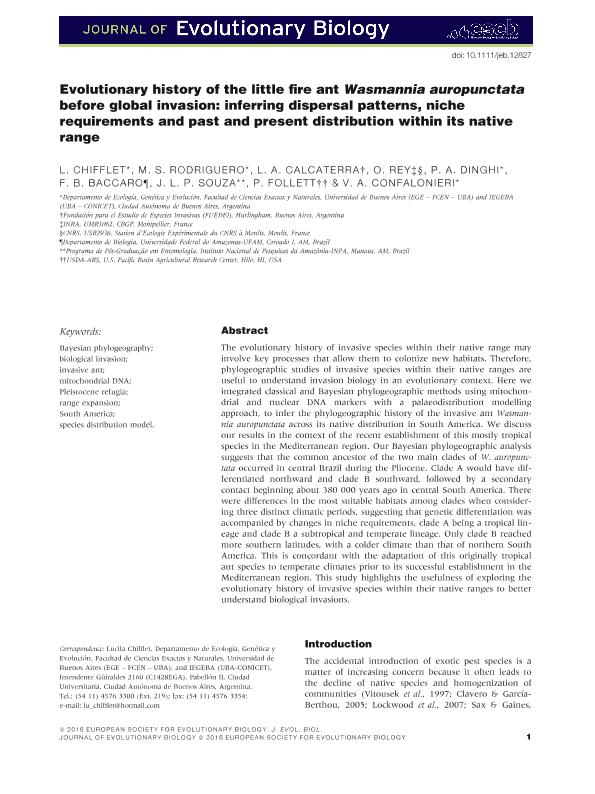Artículo
Evolutionary history of the little fire ant Wasmannia auropunctata before global invasion: inferring dispersal patterns, niche requirements and past and present distribution within its native range
Chifflet, Lucila ; Rodriguero, Marcela Silvina
; Rodriguero, Marcela Silvina ; Calcaterra, Luis Alberto
; Calcaterra, Luis Alberto ; Rey, Olivier; Dinghi, Pablo Adrián
; Rey, Olivier; Dinghi, Pablo Adrián ; Baccaro, F. B.; Souza, J. L. P.; Follett, P.; Confalonieri, Viviana Andrea
; Baccaro, F. B.; Souza, J. L. P.; Follett, P.; Confalonieri, Viviana Andrea
 ; Rodriguero, Marcela Silvina
; Rodriguero, Marcela Silvina ; Calcaterra, Luis Alberto
; Calcaterra, Luis Alberto ; Rey, Olivier; Dinghi, Pablo Adrián
; Rey, Olivier; Dinghi, Pablo Adrián ; Baccaro, F. B.; Souza, J. L. P.; Follett, P.; Confalonieri, Viviana Andrea
; Baccaro, F. B.; Souza, J. L. P.; Follett, P.; Confalonieri, Viviana Andrea
Fecha de publicación:
02/2016
Editorial:
Wiley Blackwell Publishing, Inc
Revista:
Journal of Evolutionary Biology
ISSN:
1010-061X
e-ISSN:
1420-9101
Idioma:
Inglés
Tipo de recurso:
Artículo publicado
Clasificación temática:
Resumen
The evolutionary history of invasive species within their native range mayinvolve key processes that allow them to colonize new habitats. Therefore,phylogeographic studies of invasive species within their native ranges areuseful to understand invasion biology in an evolutionary context. Here weintegrated classical and Bayesian phylogeographic methods using mitochondrialand nuclear DNA markers with a palaeodistribution modelling approach, to infer the phylogeographic history of the invasive ant Wasmannia auropunctata across its native distribution in South America. We discuss our results in the context of the recent establishment of this mostly tropical species in the Mediterranean region. Our Bayesian phylogeographic analysis suggests that the common ancestor of the two main clades of W. auropunctata occurred in central Brazil during the Pliocene. Clade A would have differentiated northward and clade B southward, followed by a secondary contact beginning about 380 000 years ago in central South America. There were differences in the most suitable habitats among clades when considering three distinct climatic periods, suggesting that genetic differentiation was accompanied by changes in niche requirements, clade A being a tropical lineage and clade B a subtropical and temperate lineage. Only clade B reached more southern latitudes, with a colder climate than that of northern South America. This is concordant with the adaptation of this originally tropical ant species to temperate climates prior to its successful establishment in the Mediterranean region. This study highlights the usefulness of exploring the evolutionary history of invasive species within their native ranges to better understand biological invasions.
Archivos asociados
Licencia
Identificadores
Colecciones
Articulos(IEGEBA)
Articulos de INSTITUTO DE ECOLOGIA, GENETICA Y EVOLUCION DE BS. AS
Articulos de INSTITUTO DE ECOLOGIA, GENETICA Y EVOLUCION DE BS. AS
Articulos(OCA CIUDAD UNIVERSITARIA)
Articulos de OFICINA DE COORDINACION ADMINISTRATIVA CIUDAD UNIVERSITARIA
Articulos de OFICINA DE COORDINACION ADMINISTRATIVA CIUDAD UNIVERSITARIA
Articulos(SEDE CENTRAL)
Articulos de SEDE CENTRAL
Articulos de SEDE CENTRAL
Citación
Chifflet, Lucila; Rodriguero, Marcela Silvina; Calcaterra, Luis Alberto; Rey, Olivier; Dinghi, Pablo Adrián; et al.; Evolutionary history of the little fire ant Wasmannia auropunctata before global invasion: inferring dispersal patterns, niche requirements and past and present distribution within its native range; Wiley Blackwell Publishing, Inc; Journal of Evolutionary Biology; 29; 4; 2-2016; 790-809
Compartir
Altmétricas



